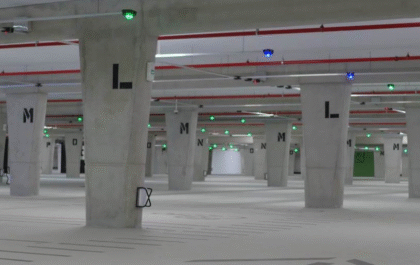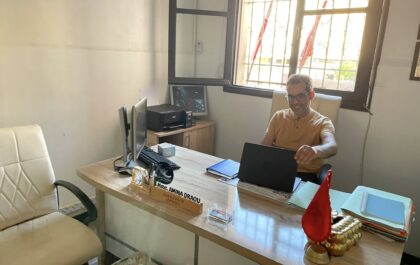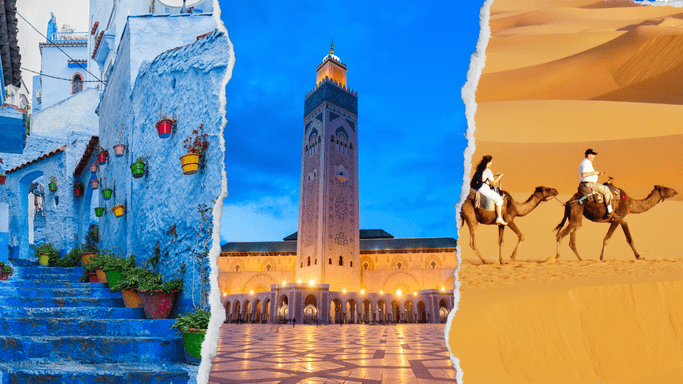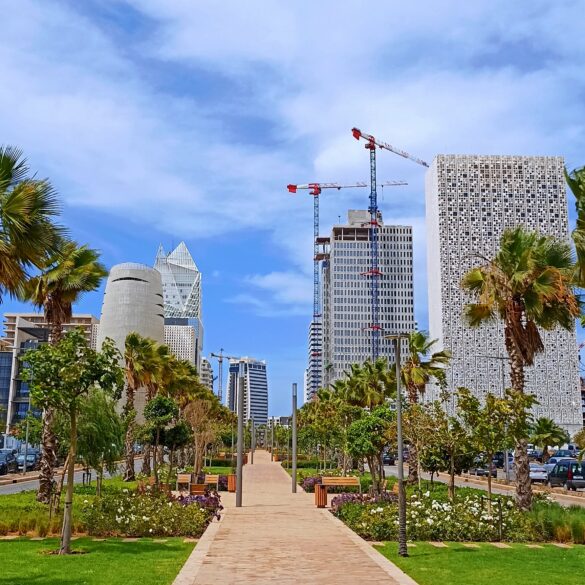Morocco in 2025 is a dazzling maze of souks, deserts, and coastal gems, and getting around is half the adventure. Whether you’re an expat settling into Casablanca’s hustle, a digital nomad chasing Wi-Fi in Chefchaouen, or a tourist snapping selfies at Jemaa el-Fna, the country’s transport network has something for everyone. From zippy high-speed trains to camel treks that feel like a movie set, Morocco’s options are affordable, diverse, and occasionally quirky. This guide is your roadmap to navigating it all with a grin, avoiding scams, and maybe even impressing a taxi driver with your French.
Getting Around Cities: Public Transport Options
In Morocco’s cities, public transport is a colorful mix of modern and chaotic. In Marrakech, where trams or metro are absent, ALSA’s air-conditioned buses, including snazzy electric double-deckers, cost about 5 MAD (roughly $0.50 / €0.45). Routes can be a puzzle for newcomers, and peak hours mean squeezing in with locals. Casablanca and Rabat boast clean, reliable trams at 6-8 MAD ($0.60-$0.80 / €0.55-€0.75) per ride, perfect for zipping through Casa’s sprawl or Rabat’s compact charm. Petit taxis, those iconic, color-coded sedans (beige in Marrakech, red in Fes, blue in Rabat), dart through traffic like caffeinated bees. A short ride costs 10-30 MAD ($1-$3 / €0.90-€2.75), but drivers might dodge the meter in touristy spots. Say “compteur, s’il vous plaît” confidently or negotiate upfront; 50 MAD ($5 / €4.60) from Jemaa el-Fna to Gueliz is fair. For hassle-free rides, apps like Heetch, InDrive, or Careem offer upfront pricing in major cities, though taxi unions occasionally grumble about them. These apps are a game-changer for avoiding overcharges, even if coverage can be spotty outside urban hubs.
Intercity Travel: How to Move Between Cities
Hopping between cities is a breeze with Morocco’s ONCF trains. The Al Boraq high-speed train, linking Tangier to Casablanca via Rabat in just over two hours, is a marvel: think sleek seats, Wi-Fi, and second-class fares of 150-300 MAD ($15-$30 / €14-€27). Conventional trains, like the three-hour Casablanca-Marrakech run, are slower but comfy, with first-class tickets around 150 MAD ($15 / €14) for extra legroom. Book via ONCF’s slick app to secure seats, especially during holidays. For destinations off the rail network, CTM or Supratours buses are reliable, with modern coaches offering AC and assigned seats for 75-350 MAD ($7.50-$35 / €7-€32), depending on distance. Book early for popular routes like Marrakech-Essaouira (100 MAD, three hours) ($10 / €9). Grand taxis, shared Mercedes sedans, are a faster, cheaper option (20-50 MAD per seat) ($2-$5 / €1.80-€4.60) for shorter routes but require patience until they fill up and a tolerance for tight quarters. Choose based on your time, budget, and craving for adventure.
Car Rentals & Driving
Renting a car unlocks Morocco’s wild side: Atlas Mountain vistas or coastal drives to Taghazout. A compact car costs 250-300 MAD ($25-$30 / €23-€27) per day, doubling in peak season. You’ll need a valid driver’s license (an International Driving Permit helps if not in English or French) and a credit card for the deposit. Highways like Casablanca-Marrakech are smooth, with tolls around 80 MAD ($8 / €7.30), but city driving is a chaotic ballet of scooters, jaywalkers, and honking. Rural roads can be treacherous, unlit, with stray donkeys, so skip night driving. Parking in cities involves “guardians” in neon vests; tip them 2-10 MAD ($0.20-$1 / €0.18-€0.90) to keep your car safe. Google Maps or Waze keeps you on track, and fuel is affordable at 12-14 MAD ($1.20-$1.40 / €1.10-€1.30) per liter. Renting shines for remote adventures, but for train-connected cities, save yourself the stress.
Domestic Flights
For long hauls like Tangier to Dakhla (2,000 km), domestic flights save time. Royal Air Maroc (RAM) and Air Arabia Maroc connect hubs like Casablanca and Marrakech to Agadir, Fes, or Oujda. A one-way Casablanca-Marrakech flight runs 500-800 MAD ($50-$80 / €46-€73), while Dakhla can hit 1,000-1,500 MAD ($100-$150 / €92-€137). Air Arabia’s budget fares dip to 300 MAD ($30 / €27) if booked early. Flights are short (45 minutes to 1.5 hours) and reliable, with modern airports in major cities. For desert trips, flying back from Errachidia after a Sahara tour beats a 12-hour bus ride. Trains often outshine flights for short routes like Casablanca-Rabat, but for far-south or eastern destinations, flying’s your friend. Use Skyscanner for deals and book early for sparse routes.
Tourist-Focused Transport
Tourists are spoiled with tailored options. Marrakech’s red hop-on-hop-off buses (190 MAD for 24 hours) ($19 / €17) loop through Majorelle Gardens and the Palmeraie, with audio guides and Wi-Fi. Tangier’s ALSA-run bus hits the Kasbah and Cap Spartel. Day trips by minibus from Marrakech to Ourika Valley or Fes to Chefchaouen cost 300-500 MAD ($30-$50 / €27-€46), handling all logistics. Multi-day Sahara tours (1,000-1,200 MAD for three days) ($100-$120 / €92-€110) blend minibus rides, camel treks, and desert camping for a bucket-list experience. For luxury, hire a private driver: 1,000-1,500 MAD ($100-$150 / €92-€137) per day for a comfy SUV and guide. Marrakech’s calèche horse carriages (150-200 MAD per hour) ($15-$20 / €14-€18) add nostalgic charm. Book through platforms like GetYourGuide for reliability, and always confirm prices upfront.
Transport Apps and Tools to Use
Smart travelers rely on apps to tame Morocco’s transport maze. The ONCF app is essential for train schedules and e-tickets, while CTM’s app or markoub.ma handles bus bookings. Heetch, Careem, and Roby simplify city rides, though coverage varies. Google Maps excels for navigation, even in medinas, with tram and bus data for Casablanca and Rabat. Waze helps drivers dodge traffic and speed traps. Movvit offers real-time bus and tram routes, untangling Casablanca’s network. Google Translate (with Arabic and French offline packs) bridges language gaps with drivers. A local SIM (50 MAD for 10 GB) ($5 / €4.60) keeps these apps running. For backup, grab paper timetables at train stations: an old-school lifesaver.
Tips & Safety for Foreigners
Morocco’s transport is safe, but scams like taxi overcharging lurk. Insist on the meter or use apps like Heetch. At airports, stick to official taxi queues (for example, 300 MAD from Casablanca to downtown) ($30 / €27). Carry small bills (5-20 MAD) ($0.50-$2 / €0.45-€1.80) for buses, taxis, and tips, as cash rules. Violent crime is rare, but guard bags in crowded buses or souks. Women travelers should feel fine in taxis (back seat’s okay) but may prefer app-based rides at night. Learn phrases like “combien?” (how much?) or “l’afak” (please) to charm drivers. Driving? Buckle up, avoid rural night roads, and expect police checkpoints (smile and wave). Bargain with humor, but know fair prices; ask your hotel. For emergencies, dial 19 for police or 15 for ambulances. Stay savvy, and you’ll glide through like a pro.
Morocco’s transport is a vibrant tapestry: affordable, varied, and occasionally a wild ride. Trains and CTM buses offer comfort for intercity jaunts, petit taxis and apps handle urban hops, and tours or rentals unlock the countryside. Challenges like taxi haggling or crowded buses are part of the charm






